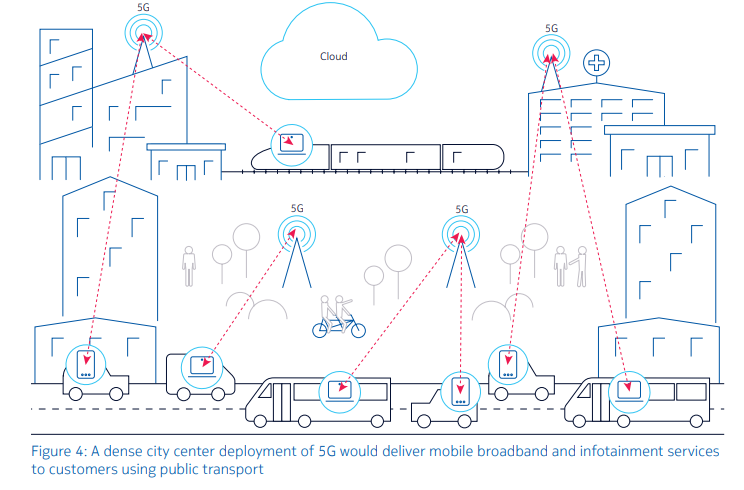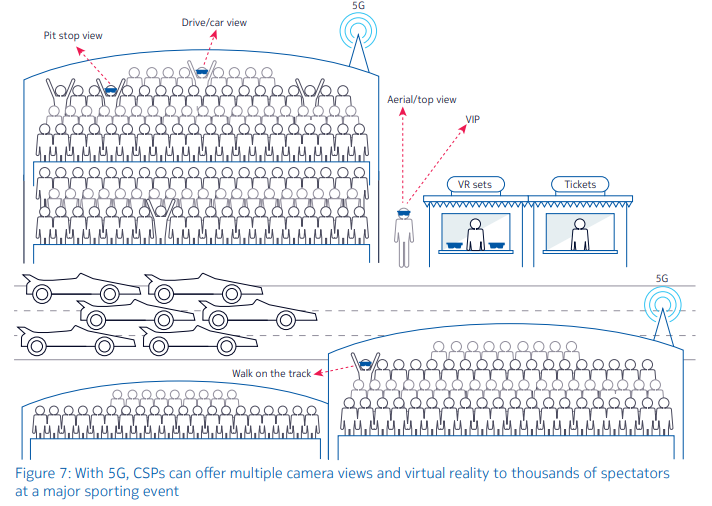
Depending on who you ask, 5G is either something to look forward to or the elephant in the room that people don’t want to – or aren’t ready to – talk about.
Though 5G realistically won’t be implemented immediately, major U.S. service providers like T-Mobile, Verizon, and Sprint are taking steps to roll out 5G networks in metropolitan areas such as Dallas, Los Angeles, and Atlanta.
As a result, we believe this is a topic that’s not worth shying away from. So, for today’s blog post, we’re going to explore several possible applications where 5G networks could be used by businesses and communities in the future.
1) Remote site safety/security and remote asset management for manufacturing
In the July 2018 VDC Research Group report entitled Exploring the State of 5G and its Industrial Opportunities, authors Pat Nolan and David Krebs explain how 5G could be instrumental in machine-to-human-to-machine applications in industrial settings. One such example they point out is with video surveillance and streaming for manufacturing asset management purposes.
This application consists of two elements: remote sensors and video cameras. If paired with low-latency, high-bandwidth connectivity, companies can use these systems to monitor their assets remotely and catch potential security threats or theft before it’s too late.
2) Wearable devices + augmented reality (AR)
When most people think of wearables, they think of Apple Watches or similar smart items. But the potential for this technology goes way beyond that when combined with augmented reality (AR), which essentially combines both reality and virtual reality together. (A famous version of AR that we’ve seen in recent years is Pokémon Go.)
In the aforementioned VDC Research report, Nolan and Krebs highlight how wearable devices and AR could be used in a manufacturing application:
“Consider the efficiencies of this situation: a remote service technician or engineer receives visual feedback from an on-site factory worker equipped with smart glasses, then provides step-by-step real-time instructors to the worker to quickly resolve an equipment repair. The low latency of a 5G network allows the factory worker to be removed from this scenario, and the service technician/engineer can instead leverage visual feedback to remote control an on-site robot to perform the maintenance.”
3) Mobile entertainment in vehicles and public transportation
Let’s say you’re driving through a city one day, and your kids are in the back, misbehaving as kids are inclined to do at times. You resort to a few options to keep them entertained (and thus behaved). Books? Nope; your kids get carsick. Listening to everyone’s favorite soundtrack? No dice; one of your kids is refusing to listen to “babyish” music now that they’re in fifth grade. So, you give them a tablet or two that have online gaming and virtual reality apps. Phew!
Chances are, if you’re in a big city, there are hundreds of other families in minivans doing the same thing. But in order for everything to work smoothly, and in order for your kids to be able to access connectivity without lags or delays, you need a network with sufficient bandwidth and speed. Enter 5G.
The application of “in-vehicle infotainment” is an exciting one posed by Nokia in their whitepaper entitled Translating 5G Use Cases into Viable Business Cases. They explain that 5G will help community service providers (CSPs) to deliver high-speed connectivity to vehicles. This can be great for both business and pleasure: on the business side, you could potentially host a video or conference call in a car, and as for fun, you – and your kids – could use your mobile devices to stream videos and play AR games. (Let’s be honest: games aren’t just for kids anymore.)
But this wouldn’t be limited to personal vehicles; cities and towns could deploy 5G on their public transportation (i.e., buses and trains). Nokia points out that the demand for mobile traffic and video traffic is expected to continue to increase, and 5G deployment would help cities to expand their cell capacity to meet this predicted demand.

The reason to do so on public transportation is simple: consumer satisfaction. Happy consumers are more likely to use your services and continue to do so. For example, a few years ago, there were plans underway to build a high-speed rail line between London and Birmingham in the UK. Proponents thought that this would save the government money. But as Ogilvy and Mather Vice Chairman (UK) Rory Sutherland argued, the government could make their public transportation users equally as content by installing Wi-Fi on their current trains. Maybe the trip would take longer, but if people riding the train could use Wi-Fi, wouldn’t they be happy? It would, after all, make the time fly by quickly. Thus, 5G could be a win-win for public transportation.
4) Hot spots for concerts, sports games, and other events in major public venues
Unless you’re wealthy, ridiculously lucky, or know people in high places, snagging VIP tickets to the latest Nickelback concert or front row seats at a Cleveland Indians game is often nothing but a pipe dream, or something that happens only once in a lifetime. But what if you could have the same kind of experience at a fraction of the cost?
In their whitepaper about viable use cases for 5G, Nokia states that this could be possible with 5G hotspots. “5G enables visitors to get close to the sporting or entertainment action without needing a high-priced VIP ticket,” they write. “Using real-time virtual reality to experience being track-side at a critical moment in a race or in the middle of a pit-stop is a powerful attraction.”
To accomplish this, entertainment venues would need to offer items like virtual reality sets and multiple camera views. With the high bandwidth and low latency of a 5G network, this could become a possibility. Viewers would be able to experience what it’s like to be in a VIP seat at a concert or in the perfect seat at a sports game simply by streaming the event on their device or on a VR set.

Conclusion
With 5G networks, the possibilities are endless. As 5G deployment occurs, we’re excited to see what will happen!
Also, are you curious to know more about 5G? Check out two of our past blog posts about fifth generation mobile networks:
